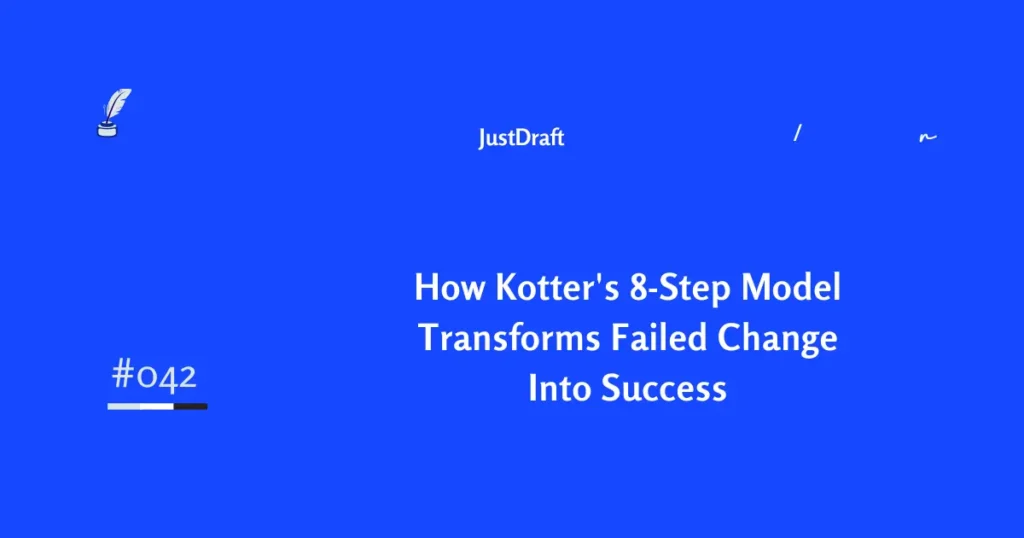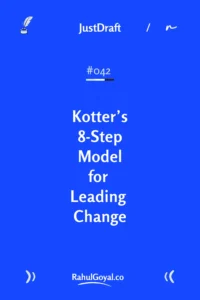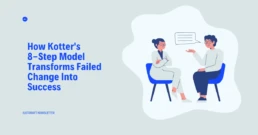How Kotter’s 8-Step Model Transforms Failed Change Into Success
Change is easy to announce. Hard to deliver.
We’ve seen it again and again—leadership rolls out a bold new direction. It looks great in slides. But somewhere between step 1 and reality, energy fizzles. Teams resist. Progress stalls. Why? Not because the idea was bad. But because the change wasn’t led. It was managed. That’s where Kotter’s 8-Step Model comes in. It’s a practical, human-first framework that helps you lead change with structure—without losing momentum.
One Topic: Kotter’s 8-Step Model
Harvard’s John Kotter conducted this game-changing research. After studying over 100 companies, he discovered that successful transformations follow a specific pattern—8 steps that separate winners from the rest.
The 8-Step Roadmap That Actually Works
- Step 1: Create Real Urgency Don’t just tell people change is needed – show them why waiting is dangerous. Share the market data, customer complaints, or competitor moves that make sitting still risky.
- Step 2: Build Your Power Coalition Change can’t happen from just the top. You need champions at every level—that respected senior developer, the customer service star everyone trusts, the operations manager who knows every process.
- Step 3: Create a Clear Vision If you can’t explain your change in 5 minutes, it’s too complex. Make it simple, compelling, and memorable.
- Step 4: Communicate Like Your Life Depends on It Say it once, you’re informing. Say it ten times, you’re starting to communicate. Repeat your vision everywhere—team meetings, emails, casual conversations.
- Step 5: Remove the Roadblocks Identify what’s stopping progress. Is it an outdated policy? A resistant manager? Lack of training? Address these head-on.
- Step 6: Score Quick Wins Nothing builds momentum like success. Celebrate early victories publicly. Make heroes out of people who embrace the change.
- Step 7: Keep Pushing Forward Use those wins to tackle bigger challenges. Don’t let success make you complacent.
- Step 8: Make It Stick The hardest part isn’t starting change—it’s making it permanent. Embed new behaviors into hiring, performance reviews, and company culture.
Why This Framework Actually Works
Unlike other change models, Kotter’s approach recognises a simple truth: people don’t resist change—they resist being changed.
The framework builds buy-in at each step. It creates urgency without panic, leadership without dictatorship, and momentum without burnout.
- It centres people. Change isn’t a spreadsheet. It’s human.
- Step-by-step. It turns a complex journey into doable actions.
- It creates real momentum. Small wins become big shifts.
- Culture is the finish line. Real change sticks when it’s embedded.
The Reality Check of Kotter 8-Step Model
Here’s what Kotter doesn’t tell you: real change is messy. You might need to loop back to earlier steps. You’ll face resistance you didn’t expect. Some quick wins won’t feel so quick.
That’s okay. The framework gives you structure, not a rigid script.
Bottom line: Lead, don’t lecture.
Kotter’s 8 steps give you a solid map—but people still need a leader. One who listens, adapts, and keeps the story alive.
Ask this often:
“How does this change feel—and stick—for our people?”
Think about a change you’re trying to make right now. Which step are you really on? Most leaders think they’re on step 5 when they’re still stuck on step 1.
Start with urgency. Make the case for why change can’t wait. Get your coalition right. Everything else becomes easier.
Change is hard, but it’s not impossible. With the right roadmap, you can transform good intentions into lasting results.
Read last week’s LensLetter newsletter about Save Your Camera in Summer.
Interested in travel, Read last week’s JustDraft about 6-3-5 Method.

Two Quotes to Inspire
Change is not about perfection—it’s about progress with purpose and persistence in execution.
The best strategies fail without the right people; the right people succeed despite imperfect strategies.
One Passage From My Bookshelf
The most general lesson to be learned from the more successful cases is that the change process goes through a series of phases that, in total, usually require a considerable length of time. Skipping steps creates only the illusion of speed and never produces a satisfying result. A second very general lesson is that critical mistakes in any of the phases can have a devastating impact, slowing momentum and negating hard-won gains. Perhaps because we have relatively little experience with renewal, even very capable people often make at least one big error.
The eight-stage process of creating major change can be summarized as follows: establishing a sense of urgency, creating the guiding coalition, developing a vision and strategy, communicating the change vision, empowering broad-based action, generating short-term wins, consolidating gains and producing more change, and anchoring new approaches in the culture. The first four steps in the transformation process help defrost a hardened status quo. If change were easy, you wouldn’t need all that effort. Phases five to seven then introduce many new practices. The last stage grounds the changes in the corporate culture and helps make them stick.
📚 From “Leading Change” by John P. Kotter


